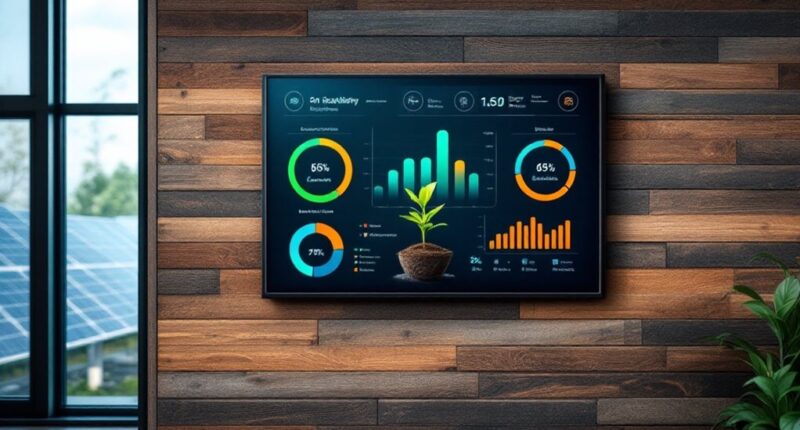Effective sustainability KPIs require a SMART approach—Specific, Measurable, Achievable, Relevant, and Time-bound metrics. Organizations should establish baseline measurements across environmental (emissions, waste), social (diversity, safety), and economic (green revenue) dimensions. Like fitness trackers for corporate sustainability, proper KPIs allow precise progress monitoring and informed decision-making. Regular reviews keep metrics relevant as standards evolve. The true power of sustainability metrics emerges when all three dimensions work in balanced harmony.

Three critical dimensions of sustainability—environmental, social, and economic—are reshaping how organizations measure success in the 21st century. Like a three-legged stool, each dimension provides essential balance for truly sustainable operations. Companies are increasingly finding that measuring these aspects isn’t just good PR—it’s good business.
Organizations committed to sustainability now navigate a rich landscape of potential Key Performance Indicators. Environmental KPIs track ecological footprints—think carbon emissions, energy consumption, and waste management metrics. Social KPIs measure human impact through diversity statistics, workplace safety incidents, and community investment. Meanwhile, economic sustainability KPIs evaluate long-term financial viability, from green revenue percentages to return on sustainability investments.
Measuring what matters—environmental footprints, social handprints, and economic vitality—transforms sustainability from aspiration to action.
Governance KPIs—the rulebook for how the sustainability game is played—have become equally important. Board diversity, transparency in reporting, and anti-corruption measures help guarantee that sustainability isn’t just window dressing but is embedded in corporate DNA. These metrics act like a corporate conscience, keeping organizations honest about their progress. Companies increasingly conduct supplier audits to ensure their entire value chain meets established sustainability standards.
Setting effective sustainability KPIs requires the finesse of a master chef—combining the right ingredients in proper proportions. The SMART framework (Specific, Measurable, Achievable, Relevant, Time-bound) provides a recipe for success. Without specificity, sustainability goals become as vague as “eating healthier someday.” Without measurement, they’re like dieting without a scale—hopeful but imprecise.
Implementation requires systematic data collection and analysis—the digital equivalent of fitness tracking for your organization. Baseline measurements establish your starting point, while targets give you something to sprint toward. Modern sustainability management software helps track progress, much like how fitness apps track steps, making the invisible visible. Many organizations are conducting regular life cycle assessments to fully understand the environmental impact of their products from creation to disposal.
The sustainability journey isn’t a short sprint but a marathon with ever-changing terrain. Regular review and stakeholder involvement guarantee KPIs remain relevant as standards evolve. After all, yesterday’s ambitious sustainability target can become today’s minimum expectation faster than you can say “carbon neutral.”
Frequently Asked Questions
How Do Sustainability KPIS Impact Financial Performance?
Sustainability KPIs drive financial performance through multiple pathways. Companies tracking environmental metrics often see reduced operational costs through energy efficiency and waste reduction. Social KPIs improve brand reputation, attracting sustainability-conscious customers and investors. Governance indicators minimize compliance risks and potential fines.
Research consistently shows organizations with robust sustainability metrics outperform peers financially, experiencing enhanced profitability, easier access to capital, stronger market valuation, and improved long-term resilience against environmental and regulatory challenges.
Can Sustainability Metrics Vary by Industry or Company Size?
Sustainability metrics undoubtedly differ across industries and company sizes. Manufacturing companies might concentrate on emissions and waste, while service firms frequently emphasize employee wellbeing. Large corporations typically utilize exhaustive tracking systems, whereas small businesses focus on targeted metrics that pack the biggest punch.
Notably, size doesn’t always dictate performance—sometimes the nimble startups outperform the corporate giants. Regardless of differences, certain universal metrics like greenhouse gas emissions and energy usage remain relevant across the sustainability spectrum.
How Often Should Sustainability KPIS Be Reviewed and Updated?
Sustainability KPIs should typically be reviewed annually, with more frequent assessments during the first year of implementation.
Organizations face varying review needs based on industry requirements, regulatory changes, and environmental risk levels. Regular updates guarantee metrics remain relevant, accurate, and aligned with evolving business goals.
The review process works best when involving cross-functional teams and benchmarking against industry standards. This systematic approach keeps sustainability efforts current and credible while demonstrating commitment to continuous improvement.
Who Should Be Responsible for Tracking Sustainability Metrics?
Responsibility for tracking sustainability metrics typically falls to dedicated sustainability or ESG teams, who serve as the central coordinators. However, effective tracking requires a collaborative approach.
Department heads contribute specialized data from their areas, while C-suite executives provide strategic oversight and accountability. External auditors verify accuracy and compliance. This multi-stakeholder approach guarantees thorough coverage, with the sustainability team orchestrating the process while departmental experts supply the detailed measurements needed for meaningful reporting.
What Technology Solutions Best Support Sustainability Data Collection?
Effective sustainability data collection relies on integrated technology solutions. IoT sensor networks capture real-time environmental metrics, while centralized data platforms consolidate this information into standardized formats.
Cloud-based sustainability software automates emissions calculations and reporting processes. AI and machine learning tools enhance data accuracy and generate predictive models. Together, these technologies create a thorough ecosystem that transforms raw environmental data into actionable insights, supporting both operational improvements and compliance requirements without overwhelming organizations with manual tracking processes.









